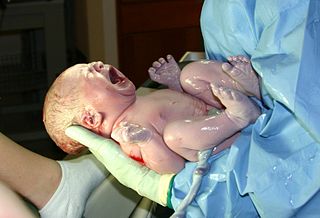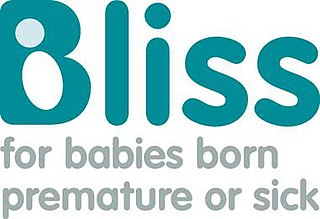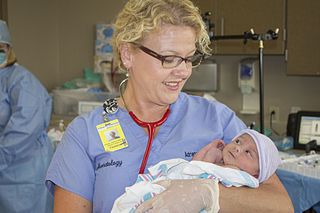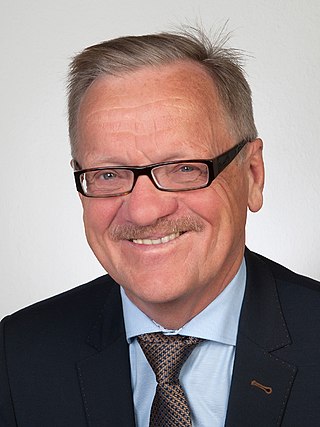Retinopathy of prematurity (ROP), also called retrolental fibroplasia (RLF) and Terry syndrome, is a disease of the eye affecting prematurely born babies generally having received neonatal intensive care, in which oxygen therapy is used because of the premature development of their lungs. It is thought to be caused by disorganized growth of retinal blood vessels and may result in scarring and retinal detachment. ROP can be mild and may resolve spontaneously, but it may lead to blindness in serious cases. Thus, all preterm babies are at risk for ROP, and very low birth-weight is an additional risk factor. Both oxygen toxicity and relative hypoxia can contribute to the development of ROP.

Patrick Bouvier Kennedy was the youngest child of United States President John F. Kennedy and First Lady Jacqueline Kennedy. His elder siblings were Caroline, John Jr., and Arabella.

Kangaroo mother care (KMC), which involves skin-to-skin contact (SSC), is an intervention to care for premature or low birth weight (LBW) infants. The technique and intervention is the recommended evidence-based care for LBW infants by the World Health Organization (WHO) since 2003.

Neonatology is a subspecialty of pediatrics that consists of the medical care of newborn infants, especially the ill or premature newborn. It is a hospital-based specialty and is usually practised in neonatal intensive care units (NICUs). The principal patients of neonatologists are newborn infants who are ill or require special medical care due to prematurity, low birth weight, intrauterine growth restriction, congenital malformations, sepsis, pulmonary hypoplasia, or birth asphyxia.

A neonatal intensive care unit (NICU), also known as an intensive care nursery (ICN), is an intensive care unit (ICU) specializing in the care of ill or premature newborn infants. The NICU is divided into several areas, including a critical care area for babies who require close monitoring and intervention, an intermediate care area for infants who are stable but still require specialized care, and a step down unit where babies who are ready to leave the hospital can receive additional care before being discharged.
Fetal viability is the ability of a human fetus to survive outside the uterus. Medical viability is generally considered to be between 23 and 24 weeks gestational age. Viability depends upon factors such as birth weight, gestational age, and the availability of advanced medical care. In low-income countries, half of newborns born at or below 32 weeks gestational age died due to a lack of medical access; in high-income countries, the vast majority of newborns born above 24 weeks gestational age survive.

NETS is an acronym for newborn emergency transport service orsystem. Such services provide critical care transport for newborn babies requiring care not available in the hospital of birth. Some provide other services; such as outreach education, return transport and coordination of high-risk obstetric transfer. Others provide transport services in older age-groups.

Montreal Children's Hospital is a children's hospital in Montreal, Quebec, Canada. Founded in 1904, it is affiliated with the McGill University Health Centre (MUHC) and McGill University, Faculty of Medicine.

Neonatal nursing is a sub-specialty of nursing care for newborn infants up to 28 days after birth. The term neonatal comes from neo, "new", and natal, "pertaining to birth or origin". Neonatal nursing requires a high degree of skill, dedication and emotional strength as they care for newborn infants with a range of problems. These problems vary between prematurity, birth defects, infection, cardiac malformations and surgical issues. Neonatal nurses are a vital part of the neonatal care team and are required to know basic newborn resuscitation, be able to control the newborn's temperature and know how to initiate cardiopulmonary and pulse oximetry monitoring. Most neonatal nurses care for infants from the time of birth until they are discharged from the hospital.

Rainbow Babies & Children's Hospital is a pediatric acute care children's teaching hospital located in Cleveland, Ohio. It is affiliated with Case Western Reserve University School of Medicine and has a neonatal intensive care unit (NICU), pediatric intensive care unit (PICU), and level 1 pediatric trauma center.
Mildred T. Stahlman is an American neonatologist and academic. She worked as a professor of pediatrics and pathology at Vanderbilt University in Nashville, Tennessee.

Bliss is a UK-based charity for infants. Bliss supports the families of babies in neonatal care and works with health professionals to provide training and improve care for babies. It campaigns for improved hospital resources across England, Scotland, Wales and Northern Ireland, and is actively involved in neonatal research.

Monroe Carell Jr. Children's Hospital at Vanderbilt, also known as Children's Hospital at Vanderbilt, is a nationally ranked pediatric acute care children's teaching hospital and entity of Vanderbilt University Medical Center in Nashville, Tennessee. The hospital is affiliated with Vanderbilt University School of Medicine's Department of Pediatrics.

A neonatal nurse practitioner (NNP) is an advanced practice registered nurse (APRN) with at least 2 years experience as a bedside registered nurse in a Level III NICU, who is prepared to practice across the continuum, providing primary, acute, chronic, and critical care to neonates, infants, and toddlers through age 2. Primarily working in neonatal intensive care unit (NICU) settings, NNPs select and perform clinically indicated advanced diagnostic and therapeutic invasive procedures. In the United States, a board certified neonatal nurse practitioner (NNP-BC) is an APRN who has acquired Graduate education at the master's or doctoral level and has a board certification in neonatology. The National Association of Neonatal Nurse Practitioners (NANNP) is the national association that represents neonatal nurse practitioners in the United States. Certification is governed by the National Certification Corporation for Obstetrics, Gynecologic and Neonatal Nursing Specialties (NCC).
Julius Hess was an American physician who is often considered the father of American neonatology. In 1922, he published the first textbook focused on the care of prematurity and birth defects in infants. That same year, Hess and nurse Evelyn Lundeen created the first premature infant station in the United States, recognizing the importance of nursing care and temperature management in the care of preterm babies. Hess also made early contributions to the transport of such infants to specialty centers.
Evelyn Lundeen was an American nurse who headed the first premature nursery in the United States with Dr. Julius Hess. Outside of her work at the nursery, Lundeen traveled to other cities to teach the principles of nursing care for premature infants. With Hess, she also co-authored an early textbook on premature baby care.
Neelam Kler is an Indian neonatologist, known for her pioneering work on neonatal intensive care and ventilation. She is credited with developing neonatal care to better the survival rate of extremely tiny preterm babies to 90 percent. The Government of India honoured her with the third-highest civilian award, Padmabhushan, in 2014, for her services to the fields of medicine and neonatology.

Herbert Barrie, was a British consultant paediatrician and a leading figure in neonatology. He was a pioneer in the emerging specialty of paediatrics and neonatal medicine; and he developed one of the first neonatal intensive care units in London.

Gerhard Jorch is a German pediatrician. He is Professor for general pediatrics and neonatology at the Otto-von-Guericke University of Magdeburg and director of the University children's hospital.
Embrace Neonatal MRI System is the first FDA-approved MRI device that can be used for head and brain scans of newborns in the NICU. The Embrace system is designed for newborns between 2.2 and 10 pounds and with a head circumference of up to 15 inches. Produced by Aspect Imaging, the Embrace contains a temperature-controlled incubator and does not require that newborns be transported out of the NICU. In case of emergencies, babies can be removed from the system in less than 30 seconds. The device has been installed in the NICU at Shaare Zedek Hospital in Israel as well as at the NICU at Brigham and Women's in the United States.
















